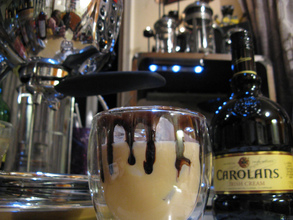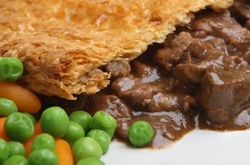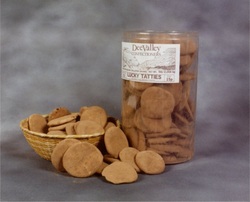
Irish Cream is a liquor based on coffee, cream and Irish whiskey. typically containing 15 to 20% of alcohol on average, the Irish Cream is served on its own or with a mixed drink. Baileys, Carolans, and Saint Brendan's are notable brands (Wikipedia, 2013).
This Beverage can be made in 2 very easy steps, the ingredients needed are:
1⅔ cups Jamison Irish whiskey
1 cup half & half or heavy cream
1 (14-ounce) can sweetened condensed milk
2 tablespoons chocolate syrup
2 teaspoons vanilla extract
1 teaspoon instant coffee
Directions
1. Combine all ingredients in a blender and puree on high speed for 30 seconds.
2. Transfer mixture to an airtight container or glass bottle with a tight-fitting lid and store in the refrigerator for up to 2 months. Shake well before using (Brown Eyed Baker, 2013).

Ashet Pie is a traditional Scottish steak pie eaten at midnight on Hogmanay (New Year's Eve) or Ne'erday (New year's Day) (Wikipedia, 2013). In Scotland it it viewed as "see in the new year" with a full steak dinner. It is commonly served with mashed potatoes and peas (Johnsen, 2012).
The ingredients for this recipe are:
1 lb (500g) topside steak (or casserole quality beef)½ lb (250g) link beef sausages½ lb (250g) ox kidney (optional)Quantity of Puff Pastry or 2 Frozen Puff Pastry Sheets2 Tablespoons flour (plain or wholemeal)Salt and pepperBeef stock cubeMedium freezer bag
Directions:
1. Heat oven to 200º C.2. Cut steak into cubes – ½ inch (1.5cm) approx.3. Slice sausages into 1 inch (2.5cm) lengths.4. Put steak, sausages, (ox kidney if used), flour, salt and pepper into freezer bag.5. Hold the bag closed and shake to coat the steak and sausage.6. Put steak and sausage into ashet (deep pie-dish) and pour over enough beef stock to cover.7. Cover ashet with aluminium foil and bake in oven for approx. 1½ hours or until tender. 8. Prepare pastry.9. Cut several strips of pastry to go round the edge of dish.10. Roll out rest so that it is big enough to fit dish.11. Take ashet from oven and grease/oil lip of dish.12. Put strips of pastry along edge.13. Brush with cold water.14. Place pastry on top and trim. (If you need to join, wet edges and press gently together).15. Replace pie in oven for 15-20 minutes until golden-brown (Johnsen, 2012).

The Irish Stew or as it is called in Gaelic "Ballymaloe" or "Stobhach Gaelach", is an old Celtic recipe dating back to the Britain Isles. It is a delicious dish made with accessible ingredients. Other than Potatoes being the main food source, the Irish would root crops and raise sheep's. They provided milk, wool for warm clothing, and cheese (Filippone, 2013).
The Stew is traditionally made of lamb, onions, parsleys and of course potatoes. the vegetables added were carrots, barleys, and turnips or parsnips. In todays cuisine, the lamb is often substituted with beef and Guiness is often added (filippone, 2013).
Here is a link to the recipe: http://www.simplyrecipes.com/recipes/irish_beef_stew/
"Irish stew is a celebrated Irish dish, yet its composition is a matter of dispute. Purists maintain that the only acceptable and traditional ingredients are neck mutton chops or kid, potatoes, onions, and water. Other would add such items as carrots, turnips, and pearl barley; but the purists maintain they spoil the true flavour of the dish. The ingredients are boiled and simmered slowly for up to two hours. Mutton was the dominant ingredient because the economic importance of sheep lay in their wool and milk produce and this ensured that only old or economically non-viable animals ended up in the cooking pot, where they needed hours of slow boiling. Irish stew is the product of a culinary tradition that relied almost exclusively on cooking over an open fire. It seems that Irish stew was recognized as early as about 1800..."
- Oxford Companion to Food, Alan Davidson [Oxford University Press:Oxford] 1999 (p. 407) (via Olver, 2013)




 RSS Feed
RSS Feed